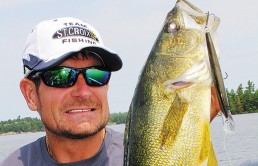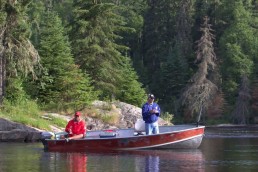Early Hot Rainy Lake Action
This year’s early spring heightens the allure of a northern Minnesota fishery like Rainy Lake. In contrast to a late ice-out year when water temps in the low 40s can dominate during the Minnesota Walleye Opener (second Saturday in May), this is not going to be one of those years. A corollary: With May 1 falling on a Sunday this year, the Opener is on the latest possible day it can be, May 14. The result: Walleyes will have completely recovered from the spawning ritual and have rolled with gusto into the post-spawn feedbag by the time walleye anglers are targeting Minnesota’s most popular gamefish.
Think shallow for May walleyes on Rainy Lake. With water temperatures straddling 60 degrees, it can be lights out for both big numbers of fish as well as impressive average-sized fish in less than 10 feet of water. This fishery overlays the Canadian Shield, with a predominant granite base, but with also plenty of bottom content consisting of gravel that is ideal for the walleye spawn. After the conclusion of the spawn, a majority of walleyes—even bigger females—will remain in the shallows to recuperate and feed. The shallow water bite can hold firm, well into late June.
A potential shooting gallery for three major gamefish species is a primary early-season attraction for anglers. While walleyes offer the main draw, Rainy Lake also is a world-class smallmouth bass destination. Big bronzebacks will dominate the shallows long after the walleyes start to slide into the deeper shoreline breaks and migrate to the main basin reefs for the summer and fall. Smallies thrive in the same gravel/rubble/boulder substrate as the walleyes, and during the peak June (and sometimes) July moon phase, the bass will be bedding hard. Prior to their peak spawn, and for weeks afterward, they are easy pickings with a wide range of lure presentations. Rig up your favorites and enjoy the action.
Big northern pike prowl these waters, and once the peak summer fishing season arrives, they can be a difficult species to consistently catch as the biggest specimens tend to roll into deep water and suspend, roaming the open basins to feed. It’s not uncommon for walleye fishermen in July and August to be reeling in these fish from the main lake reefs and experience the thrill of a 20-pound-plus pike wrestling with their hooked fish. Sometimes you’ll get lucky and be able to net the pike, if it’s long enough. Along with a walleye gripped crossways in its toothy jaws, but on most occasions, the big predator will just shake the walleye like a puppy with a chew toy before releasing it boat-side.
If you journey to Rainy Lake in the last two weeks of May, you’re likely to encounter huge northern pike still holding in the shallows. If you discover water temps below the mid-60s, your opportunities will increase. To seriously target pike, use water temperatures as one of your key indicators. Aim for the 60-degree range in any back bays—especially with a mud bottom that will warm quickly if the main basin is still in the low to mid-50s—and distance yourself from any backwaters that are too warm. Follow the shoreline routes out of these areas toward main lake points, where big pike will stage before pulling out to the basin for the balance of the summer.
If you are way back in the bays, throw buzzbaits, floating twitchbaits or wakebaits (eg. Rapala’s BX Waking Minnow #13), large-profile topwaters (the new Arashi Top Walker 11’s and 13’s are killer baits) as well as bulky “fluke-style” soft plastics rigged to slow-fall. Switch presentations to match the deeper shorelines as you vacate the backwaters and approach the main lake areas. Rocky shorelines leading to the lake basin will have sharper breaklines, necessitating a switch to larger jerkbaits like number 12 and number 14 Husky Jerks and 3/4- to 1-ounce spinnerbaits with a number 5 or number 6 nickel willowleaf blade. Windswept shorelines generally are more productive, as the first shoreline point jutting out to the basin as you leave the back bays can be a perennial hot spot if water temps are 60 and the wind is blowing into the point.
A similar location strategy holds true for Rainy Lake walleyes, but avoid venturing too far back into bays and pay particular attention to bottom content. You won’t contact many walleyes in a soft bottom or sandy area. Focus on rocky shorelines and out to the main lake points, just as you would for northern pike. On Rainy Lake in the spring, it’s likely you’ll catch walleyes, bass, and northern pike on most of these shorelines.
An obvious and easy tactic, especially for boating loads of walleyes, is a light jig tipped with a lively minnow. In most instances, 1/8- to 1/4-ounce jig heads will be all you need. Color is less important than maintaining light contact with the bottom as you gently hop the jig back toward the boat. You also want to minimize snags, so throw the absolute lightest jig you can get away with, given the conditions.
And while windy shorelines will hold active fish, you’ll lose sensitivity. Compensate by spooling with Sufix 832 Braid or the all-new Sufix Nanobraid knotted to a 6-pound fluorocarbon leader on the business end. As an alternative to live bait, thread a small paddle tail plastic on your jig head to spend less time with your hand in the minnow bucket. When the bite is hot (multiple consecutive casts), you don’t need live bait to trigger strikes from walleyes, and the durability of a plastic trailer is hard to beat.
Another deadly tactic involves casting small crankbaits. Small lures ideally match small spring baitfish profiles, and the thunderous strikes delivered by big walleyes to a rapidly wobbling lure make every cast a memorable one. Stick with silver or gold color patterns for the most part, but definitely experiment with colors to see if the fish are showing a preference. Sometimes, FireTiger or orange patterns get the upper hand. Rainy has the light whiskey color tannic acid-stained color (leeching from the tamarack swamps), but still has good overall water clarity, making it a killer jerkbait lake for walleyes and smallies. If you like to throw jerkbaits for bass, this is a perfect fishery to tag-team both bass and walleyes with this technique.
Big Walleyes, try deeper
If you’re catching smaller specimens from 2 to 6 feet of water pull your boat another cast-length out away from shore and continue casting as you were before. Some folks struggle mentally with not throwing their lure all the way to the edge of the shoreline, but fish as if you were doing so. If you’re jig fishing, switch to a heavier jig (if you need to in order to maintain contact with the bottom) to work the 6- to 12-foot depths and you’ll likely find bigger walleyes along these deeper edges. If casting a crankbait or jerkbait, initiate your retrieve with rod tip down to drive the lure deeper in the water column at the start of retrieve, and hold on tight—the big girls that have slid away from the shore to hold in deeper water will shoot upward to blast your lure. Fish cannot resist the enticing pause and hover of a Shadow Rap or Husky Jerk out in open water off that deeper breakline. I’m excited to throw the brand new Shadow Rap Shad, a lure that features a slow rise on the pause that imitates a severely stunned baitfish struggling to survive. I’m sure our southern readers are already clobbering big bass in reservoir systems with this new lure.
MWO
SHARE THIS POST
Did you enjoy this post?
You can be among the first to get the latest info on where to go, what to use and how to use it!




